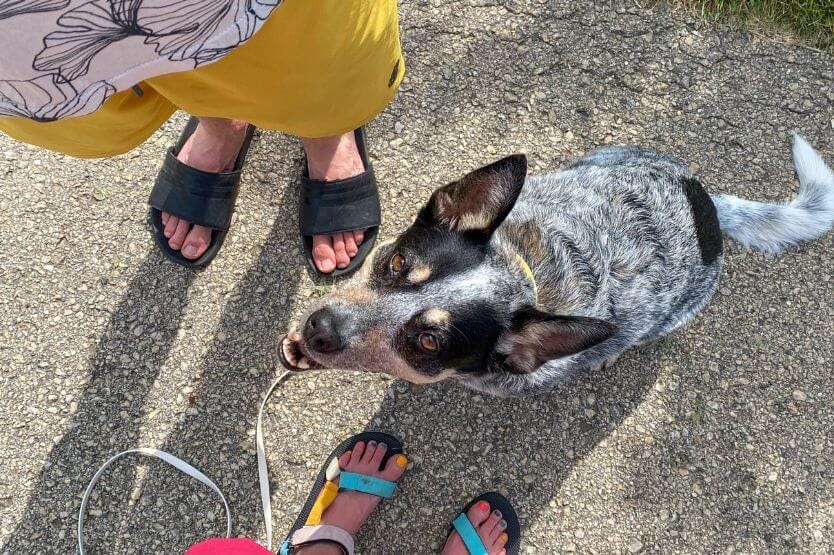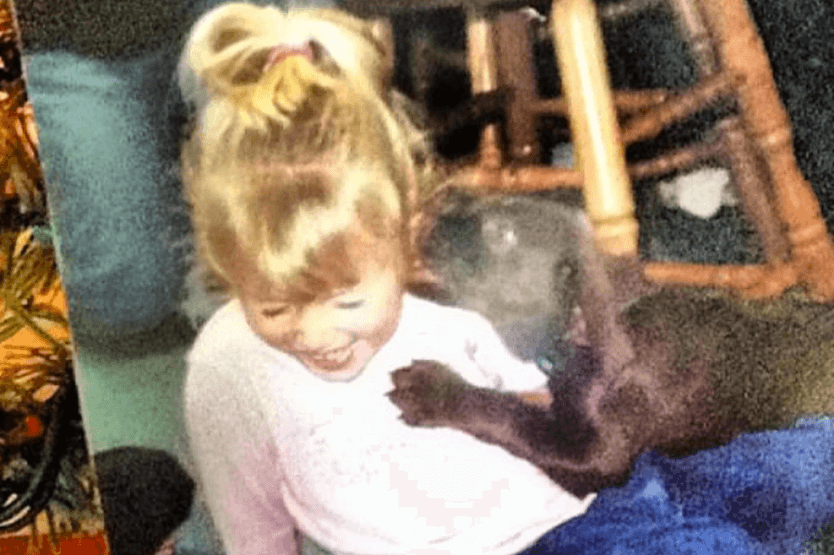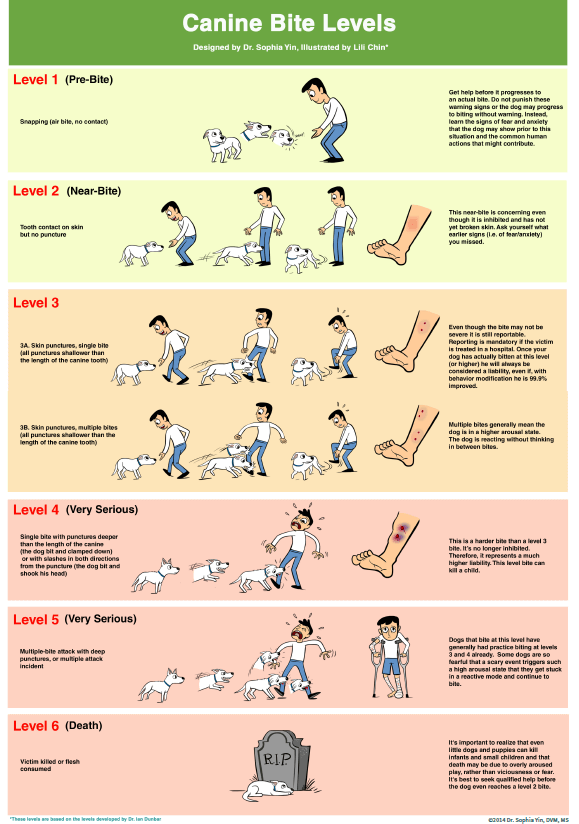Is it ever okay for a pet dog to bite?
A lengthy response to a reductionist Instagram reel
Last month I saw an Instagram reel emphatically claim “Pet. Dogs. Shouldn’t. Bite.”
The on-video text was a list of excuses dog owners might make for their pets’ behavior: “He’s a rescue, he’s anxious, he sleep startled, it’s just a nip, it didn’t break the skin, he’s nervous, he doesn’t like that, we made mistakes when he was a puppy, it’s a fear period, he’s friendly really, he didn’t mean it, he hates the vet, he was eating, he really likes that toy, his bucket was full, children freak him out, it’s only people with hats, your dog started it, it was an air snap, he didn’t mean to hurt me, he was tired, he was too excited, I went over to him, it’s his bed, let sleeping dogs lie, it’s not a real bite, it’s just noise, he’s wary of strangers, it’s only men that he bites, it was out of the blue, he goes from 0-100 with no warning…”
The post inspired mixed feelings. Here’s my attempt to distill them into a coherent take.
TLDR: If you only skim one thing
We should not put people or pets at risk. We should not minimize chronic aggression. Frustration tolerance, advocacy, and clear-eyed assessments are key.
We should allow our dogs to have and express boundaries. It’s unfair to expect pets to never growl, snap, or otherwise tell us they’re having a hard time.
My initial reaction
I wholeheartedly agree we shouldn’t normalize aggression—particularly unprovoked aggression—in pet dogs. We should breed for temperament. We should teach frustration tolerance. We should consider what traits make canine companions successful in our modern society and do our best to hone them!
I also think we need to understand our dogs as dogs. Yes, we domesticated them. I practically never shut up about our incredible coevolved relationship. But they still don’t “have words” the way humans do (we so often tell children to “use your words” instead of resorting to cruder expressions of displeasure)—and we need to unpack the semantics of what “bite” means to have a productive conversation.
My dog bite background
When I was five, a border collie nipped me. I had to go to the hospital. This is not an experience I wish on anyone, especially any child, and I’m fortunate I had enough positive interactions with dogs that it didn’t affect me long term. (Some of my loved ones have struggled with decades-long cynophobia after bite incidents.)
As I’ve gotten older, I’ve also developed more empathy for that dog. He was a herding breed, an unfamiliar kid was behaving erratically in his home, and no adult stepped in. I was small enough that his nip—not a high level bite—just broke skin. He was not a “dangerous dog” by default. He still caused harm under the circumstances.
(I can say the same about many humans.)
Dogs communicate with their mouths—but not by talking
Canines don’t communicate the same way humans do. To us, physical aggression is largely unacceptable. To them? It’s a normal part of social interactions.
Scout does not have a verbal vocabulary to say “hey, please stop that” and finally escalate to “knock if OFF!” Instead, she starts with stiff body language. She makes herself small while showing the whites of her eyes. She frantically licks her lips. And finally, if I ignore (or miss) all those signals, she might escalate to a snap. As DVMs with VCA Animal Hospitals say, “dogs may be quite effective communicators but they still only know how to express themselves with their own canine communication.”
Why do dogs need to communicate with us at all? Because they’re sentient beings with feelings and preferences. Our relationships should go both ways!
Expecting Disney-level tolerance in our companions is a problem in today’s pet ownership world. So many of us demand “friendliness” from our dogs (a loaded word in itself) and either vilify them or belittle ourselves when they tell us they’re uncomfortable.
But no one is “friendly” all the time. And when canines integrate with primates—domestic dogs with us humans—our interactions are rife with opportunities for misunderstanding. Patricia McConnell’s The Other End of the Leash covers core communication differences. We are social creatures continuing to refine our signals. If I don’t perfectly understand my dog (and I definitely don’t) I can’t expect her to perfectly understand me and our human society either.
Dogs have a right to express discomfort
When I showed the video that inspired this reflection to Sean, his first reaction was “I bet I could get a lot of dogs to at least snap at me if I was awful enough to them.” If he actually tried to make that happen, it would be his fault—not the dogs’.
Scout once air snapped at a group class trainer who repeatedly violated her boundaries. The trainer said it was a courteous correction. I agreed. None of us were concerned about her long-term behavior. (I did, of course, feel terrible for not better advocating—having my dog’s back is one of my greatest values.)
Based on the on-screen text of that video, “it was an air snap” is an irresponsible excuse to make. But was Scout’s “hey, I’ve been throwing out stress signals for 30 seconds and you still won’t stop grabbing my paws” as worrying as a high level bite? If I talk about her snap as appropriate communication in that context, am I normalizing problematic aggression?
I don’t think so. I think I’m being fair to my dog.
We shouldn’t treat all bite levels the same way
I recently watched an acquaintance’s dog snap at his owner. While I think she thought she was “just playing”, she did not respect her Schnauzer’s cues. Throughout our visit he cowered after she tossed him in the air like a toddler and shook after she vigorously rubbed his head.
Then she tugged his ear. He obviously didn’t like it. After several repetitions he snapped at her hand—and I thought his reaction was completely warranted. She beyond pestered him. Rescue workers at Animal Friends Inc note “a growl or snap is your dog’s way of communicating a warning—and [the good news is] your dog is choosing to warn you instead of biting.” Limiting himself to an air snap showed restraint.
But if we generalize “pet dogs shouldn’t bite” (and include “air snap” under the umbrella of bite) we put the onus on this dog to be ceaselessly tolerant in an unfair situation… instead of on his owner to treat him well.
Dog bite scale courtesy of Dr. Ian Dunbar
Adapted by Dr. Sophia Yin:
Level 1 (pre-bite): No skin-contact by teeth. Snapping (air bite).
Level 2 (near-bite): Skin-contact by teeth but no skin-puncture.
Level 3: Shallow punctures from a single or multiple bites with no puncture deeper than half the length of the dog’s canine teeth.
Level 4: Single bite with deep punctures (the dog bit and clamped down) or with lacerations in both directions (dog held on and shook head from side to side).
Level 5: Multiple-bite incident with at least two Level 4 bites or multiple-attack incident with at least one Level 4 bite in each.
Level 6: Death. (It’s worth noting dog bite deaths are rare—but they do happen. Janis Bradley’s Dogs Bite: But Balloons and Slippers Are More Dangerous provides great context here.)
The Association of Professional Dog Trainers says “levels one and two comprise well over 99% of dog incidents. The dog is certainly not dangerous and more likely to be fearful, rambunctious, or out of control. Wonderful prognosis.”
Debra Horwitz, DVM, DACVB and Gary Landsberg, DVM, DACVB, DECAWBM write that “the severity of a bite may be assessed by careful consideration of the situation, the damage caused by the bite, the choices the dog made including the dog’s willingness to avoid escalation to a bite by growling, snarling or snapping and the diagnosis of type of aggression.” (Quotation source; emphasis my own.)
Careful consideration of the situation: When is it okay for a dog to growl, snap, or bite?
Was the dog being harmed? Was there a reason for defensive aggression? Were they in pain?
There’s a huge difference between a dog who air snaps after a lengthy period of unfair treatment and a dog who goes for a high level bite with little warning. We don’t say humans who yell at strangers harassing them on a city sidewalk have anger issues. We do say that about people who scream at their partners over nothing.
The dog’s willingness to avoid escalation: How much intent to harm was there?
Did the dog try to communicate their discomfort without teeth first? Did they mediate their bite response?
If the situation was extreme and a dog reacted with nothing more than an air snap, I’m thinking they’re pretty safe. If the situation was benign and they launched all the way to a level three or four bite, though? I’m drawing the opposite conclusion.
How do we know if a dog is safe to be around?
I want to feel at ease around Scout. Sean and I are comfortable with her. She has preferences, and she expresses those preferences—and if I totally roll atop her sore hip she will let me know with a yelp or growl or even small snap. But in the normal course of our lives I am never afraid she is going to hurt me.
This is a loose distinction. We all have different personal associations and comfort levels. I could probably write another 2,000 words trying to answer what it means to feel at ease. Blurry as it is, “can people relax around the dog” is still my go-to litmus test for whether a dog is safe (and simply communicating in a natural way) or dangerous (and we have a problem requiring immediate attention).
I should feel able to interact with my dog normally, social creature to social creature, without fear. I should adjust to her preferences within reason, the same way I ask her to adjust to mine. And we should have wiggle room for mistakes—they’re inevitable in any relationship—before things reach physical harm.
My dog doesn’t have to be a robot who never gets upset for all that to be true.
Excuse? Or valid explanation?
Back to the on-video text: “He’s a rescue, he’s anxious, he sleep startled, it’s just a nip, it didn’t break the skin, he’s nervous, he doesn’t like that, we made mistakes when he was a puppy, it’s a fear period, he’s friendly really, he didn’t mean it, he hates the vet, he was eating, he really likes that toy, his bucket was full, children freak him out, it’s only people with hats, your dog started it, it was an air snap, he didn’t mean to hurt me, he was tired, he was too excited, I went over to him, it’s his bed, let sleeping dogs lie, it’s not a real bite, it’s just noise, he’s wary of strangers, it’s only men that he bites, it was out of the blue, he goes from 0-100 with no warning…”
I’m uncomfortable grouping all these statements together. Depending on the context, some sound reasonable. Others grasp at straws.
Ways I do not think we should dismiss a bite incident (of any level)
“He’s a rescue, he’s friendly really, he didn’t mean it, it’s only men that he bites, it was out of the blue, he goes from 0-100 with no warning, he only bites when he’s angry…”
“It was out of the blue” and “he goes from 0-100 with no warning” are particularly concerning. It’s on us, as responsible pet owners, to keep tabs on our dogs’ signals. In order for us to do that, they need to give us time to step in! A dog who jumps to high level aggression without preceding cues is not safe in our society.
Ways I think it’s okay to give context about a low-level bite incident
“It’s just a nip, it didn’t break the skin, he doesn’t like that, he hates the vet, he was eating, he really likes that toy, his bucket was full, children freak him out, your dog started it, it was an air snap, it’s his bed, it wasn’t a real bite”
Variations of “it was an air snap” and “it didn’t break the skin” help determine bite level. We should not ignore low level bite incidents simply because they’re low level—but we’d be remiss to react the same way to a well-inhibited correction and an unprovoked level four.
What caused the bite incident?
“He was eating” and “he really likes that toy” and “it’s his bed” suggest resource guarding issues. Again, we should not ignore these signs—but we should understand them in their larger context. A dog who growls or snaps when someone interferes with their food bowl is not inherently dangerous. Can we train greater tolerance if we live in an environment where we feel it’s necessary? Yes, we can. Yes, we should. But natural responses don’t mean our dogs are unhinged.
“He doesn’t like that” and “his bucket was full” (meaning he was at his limit; he was overwhelmed) can help us understand where our dogs are coming from. Is high level aggression acceptable in a pet dog? No. I can’t be clear enough about that. But we can empathize with an animal who’s had a rough day and “raises his voice” at the final straw. (I know I’ve been there.)
“Your dog started it” could be similar to the above. I expect Scout to be safe and under control in human society. I don’t expect her to take everything on the chin, though. If another dog instigated a fight and she bit back, I would not automatically dub her dangerous. Same if a human harassed her and she air snapped. My goal is to build frustration tolerance so that my dog’s fuse is long—but if she reaches the end of her metaphorical rope? I’m going to try to understand the situation before jumping to generalizations.
Dismissing is different than discussing
Dismissing any bite incident—acting like it didn’t happen—is irresponsible.
Giving context about a bite incident—placing it on the bite scale, understanding what causes it, then using that information to inform future actions—is the opposite.
Instead of “pet dogs shouldn’t bite”
I propose “pet dogs should not immediately escalate to high level bites” or “pet dogs should express discomfort at a level proportional to the situation” as more nuanced alternatives.
And I’d like to add some “pet owners should” statements to address the human end of the leash, too. “Pet owners should treat their dogs with respect, pet owners should not push their dog’s boundaries for amusement, pet owners should learn about canine body language and dog bite prevention.”
A final note on social media messiness
The creator of the video initially inspiring these thoughts is a lovely dog owner with salient personal experiences that help me understand her post. I think it’s important to consider how different people might interpret different phrases—but my writing about the nuance I see is not meant to imply the author had ill intent.
Internet communication is messy. We do the best we can. Thanks for taking the time to read if you’ve made it this far. Now go play with your dog!





